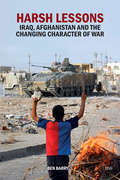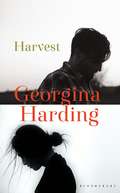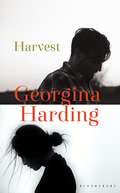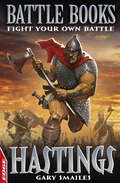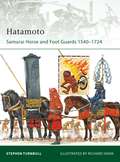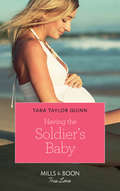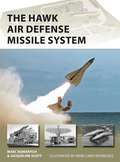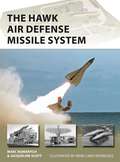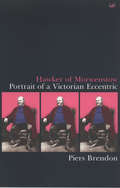- Table View
- List View
Harry’s War
by Harry Drinkwater Jon Cooksey David Griffiths‘I saw several fellows fall, one fellow coughing up blood and all the time, bullets were hacking about me. I ran for about 70 yards carrying with me all the Lewis gun things I had brought up and dropped breathless into a shell hole headlong onto a German who had been dead for months.’Harold Drinkwater was not supposed to go to war. He was told he was half an inch too short. But, determined to fight for king and country, he found a battalion that would take him and was soon on his way to the trenches of the Somme. As the war dragged on, Harry saw most of the men he joined up with killed around him. But, somehow, he survived.Soldiers were forbidden from keeping a diary so Harry wrote his in secret, recording the horrendous conditions and constant fear, as well as his pleasure at receiving his officer's commission, the joy of his men when they escaped the trenches for the Italian Front and the trench raid for which he was awarded the Military Cross. Harry writes with such immediacy it is easy to forget that a hundred years have passed. He is by turns wry, exhausted, annoyed, resigned and often amazed to be alive. Never before published, Harry's War is a moving testament to one man's struggle to keep his humanity in the face of unimaginable violence.
Harsh Lessons: Iraq, Afghanistan and the Changing Character of War (Adelphi series)
by Ben BarryThe recent Afghanistan and Iraq wars were very controversial. The conflicts’ casualties, intractability and the apparent failure of the US and its allies to achieve their objectives mean that many see the wars as failures. This resulted in a loss of confidence in the West of the utility of force as an instrument of state power. Both wars have been well described by journalists. There is no shortage of memoirs. But there is little discussion of how the conduct of these wars and capabilities of the forces involved changed and evolved, and of the implications of these developments for future warfare. This book gives readers a clear understanding of the military character dynamics of both wars and how these changed between 2001 and 2014. This includes the strategy, operations, tactics and technology of the forces of the US and its allies, Afghan and Iraqi government forces as well as insurgents and militias, showing how they evolved over time. Many of these developments have wider relevance to future conflicts. The book identifies those that are of potential wider application to US, NATO and other western forces, to insurgents, as well as to forces of states that might choose to confront the west militarily.
Harsh Lessons: Iraq, Afghanistan and the Changing Character of War (Adelphi series)
by Ben BarryThe recent Afghanistan and Iraq wars were very controversial. The conflicts’ casualties, intractability and the apparent failure of the US and its allies to achieve their objectives mean that many see the wars as failures. This resulted in a loss of confidence in the West of the utility of force as an instrument of state power. Both wars have been well described by journalists. There is no shortage of memoirs. But there is little discussion of how the conduct of these wars and capabilities of the forces involved changed and evolved, and of the implications of these developments for future warfare. This book gives readers a clear understanding of the military character dynamics of both wars and how these changed between 2001 and 2014. This includes the strategy, operations, tactics and technology of the forces of the US and its allies, Afghan and Iraqi government forces as well as insurgents and militias, showing how they evolved over time. Many of these developments have wider relevance to future conflicts. The book identifies those that are of potential wider application to US, NATO and other western forces, to insurgents, as well as to forces of states that might choose to confront the west militarily.
Harvest
by Georgina HardingSo fresh and free she looked, in the yellow dress. Sunlight to blaze away the shadows. A farm in Norfolk in the 1970s. A Japanese girl comes to visit her English lover in the house where he was born. She arrives on a day of perfect summer, stands with his mother in a garden filled with roses, watches as his brother walks fields of ripening wheat.But between the two brothers lies the shadow of their father's violent death almost twenty years before, the unresolved narrative of their childhood – a story that has gone untold, a story that began in the last war. In the presence of the girl, the old trauma begins to surface as the work of the harvest begins.In a compelling addition to Harding's cycle of acclaimed novels on themes of witness, memory and silence, on what goes unsaid long after wars are over, Harvest tells how a family reaps the consequences of its past.
Harvest
by Georgina Harding'I would compare her to writers like Helen Dunmore, Elizabeth Strout, Jon McGregor' BBC Radio 4'Harding achieves a weighty sense of silence and things not said in this unsettling book about the aftershocks of trauma and the burdens of bearing witness' Sunday Times'A masterly achievement, illuminating with wisdom and compassion the darkest corners of the human heart' GuardianSo fresh and free she looked, in the yellow dress. Sunlight to blaze away the shadows. A farm in Norfolk in the 1970s. A Japanese girl comes to visit her English lover in the house where he was born. She arrives on a day of perfect summer, stands with his mother in a garden filled with roses, watches as his brother walks fields of ripening wheat.But between the two brothers lies the shadow of their father's violent death almost twenty years before, the unresolved narrative of their childhood – a story that has gone untold, a story that began in the last war. In the presence of the girl, the old trauma begins to surface as the work of the harvest begins.In a compelling addition to Harding's cycle of acclaimed novels on themes of witness, memory and silence, on what goes unsaid long after wars are over, Harvest tells how a family reaps the consequences of its past.'Taut and unsettling ... A fine meditation on war's long reach' Mail on Sunday
Harvest of Despair: Life and Death in Ukraine under Nazi Rule
by Karel C. Berkhoff“If I find a Ukrainian who is worthy of sitting at the same table with me, I must have him shot,” declared Nazi commissar Erich Koch. To the Nazi leaders, the Ukrainians were Untermenschen—subhumans. But the rich land was deemed prime territory for Lebensraum expansion. Once the Germans rid the country of Jews, Roma, and Bolsheviks, the Ukrainians would be used to harvest the land for the master race. Karel Berkhoff provides a searing portrait of life in the Third Reich’s largest colony. Under the Nazis, a blend of German nationalism, anti-Semitism, and racist notions about the Slavs produced a reign of terror and genocide. But it is impossible to understand fully Ukraine’s response to this assault without addressing the impact of decades of repressive Soviet rule. Berkhoff shows how a pervasive Soviet mentality worked against solidarity, which helps explain why the vast majority of the population did not resist the Germans. He also challenges standard views of wartime eastern Europe by treating in a more nuanced way issues of collaboration and local anti-Semitism. Berkhoff offers a multifaceted discussion that includes the brutal nature of the Nazi administration; the genocide of the Jews and Roma; the deliberate starving of Kiev; mass deportations within and beyond Ukraine; the role of ethnic Germans; religion and national culture; partisans and the German response; and the desperate struggle to stay alive. Harvest of Despair is a gripping depiction of ordinary people trying to survive extraordinary events.
Harvest of Thorns
by Shimmer ChinodyaHarvest of Thorns tells the powerful story of Benjamin, a young soldier returned from the frontlines of the Zimbabwe Civil War, forced to ask himself what it means to be free in the new Zimbabwe. Isolated and troubled at boarding school, Benjamin is fascinated by the idea of fighting for the liberation of Rhodesia and transforming it into an independent nation. But upon returning home from the war, he quickly discovers that independence has come at a great cost and that little has changed in his small town. While facing the realities of post-revolution life, Benjamin tries to find happiness in a desperate situation. Shimmer Chinodya unravels the extraordinary story of Zimbabwe's liberation through masterful storytelling, exploring the profound effects liberation had on society as well as at the level of the individual. 'Remarkable.' Chimamanda Ngozi Adichie'A brutal, honest account of the freedom fighter's struggle for independence in Zimbabwe.' Guardian 'A humane and penetrating look at a brutal government and a bloody revolution.' Publishers Weekly
A Harvest Truce: A Play (Harvard Library of Ukrainian Literature #9)
by Serhiy ZhadanBrothers Anton and Tolik reunite at their family home to bury their recently deceased mother. An otherwise natural ritual unfolds under extraordinary circumstances: their house is on the front line of a war ignited by Russian-backed separatists in eastern Ukraine. Isolated without power or running water, the brothers’ best hope for success and survival lies in the declared cease fire—the harvest truce. But such hopes are swiftly dashed, as it becomes apparent that the conflagration of war will not abate.With echoes of Waiting for Godot, Serhiy Zhadan’s A Harvest Truce stages a tragicomedy in which the commonplace experiences of death, birth, and the cycles of life marked by the practices of growing and harvesting food are rendered futile and farcical in the wake of the indifferent juggernaut of war.
Hastings: EDGE: Battle Books (EDGE: Battle Books #6)
by Gary SmailesTake up your weapons and prepare to fight your own battle in these all-action, interactive adventures, in which you take part in epic battles from throughout history.It is 1066, and Harold Godwinson has been crowned King of England. A mighty army has journeyed from Normandy, Breton and France to crush Harold's forces at what will become remembered as the Battle of Hastings. You are William the Conqueror, Duke of Normandy and leader of one of the largest invasion forces ever. You must command your army and position your forces to defeat the English, and claim the crown that is rightfully yours...
Hatamoto: Samurai Horse and Foot Guards 1540–1724 (Elite)
by Stephen Turnbull Richard HookEach great samurai warlord, or daimyo, had a division of troops known as the Hatamoto, 'those who stand under the flag'. The Hatamoto included the personal bodyguards, the senior generals, the standard bearers and colour-guard, the couriers, and the other samurai under the warlord's personal command. Apart from bodyguard and other duties in immediate attendance on the daimyo, both horse and foot guards often played crucial roles in battle. Their intervention could turn defeat into victory, and their collapse meant certain defeat. As favoured warriors under the warlord's eye, members of the bodyguards could hope for promotion, and a few even rose to be daimyo themselves. All the three great leaders of the 16 and 17th centuries – including Oda, Hideyoshi and Tokugawa – had their own elite corps. Such troops were naturally distinguished by dazzling apparel and heraldry, with banners both carried and attached to the back of the armour, all of which will be detailed in an array of colour artwork specially created for this publication.
Hatamoto: Samurai Horse and Foot Guards 1540–1724 (Elite)
by Stephen Turnbull Richard HookEach great samurai warlord, or daimyo, had a division of troops known as the Hatamoto, 'those who stand under the flag'. The Hatamoto included the personal bodyguards, the senior generals, the standard bearers and colour-guard, the couriers, and the other samurai under the warlord's personal command. Apart from bodyguard and other duties in immediate attendance on the daimyo, both horse and foot guards often played crucial roles in battle. Their intervention could turn defeat into victory, and their collapse meant certain defeat. As favoured warriors under the warlord's eye, members of the bodyguards could hope for promotion, and a few even rose to be daimyo themselves. All the three great leaders of the 16 and 17th centuries – including Oda, Hideyoshi and Tokugawa – had their own elite corps. Such troops were naturally distinguished by dazzling apparel and heraldry, with banners both carried and attached to the back of the armour, all of which will be detailed in an array of colour artwork specially created for this publication.
Hattie's Home
by Mary GibsonA passionate and heartwarming saga from the bestselling author of CUSTARD TARTS AND BROKEN HEARTS. January 1947. The war is over. But London is still a wasteland. After eight years in the ATS, Hattie Wright returns to a Bermondsey she doesn't recognise. With so few jobs, she reluctantly takes work at the Alaska fur factory – a place rife with petty rivalries that she vowed never to set foot in again. But while she was a rising star in the ATS, Hattie's work mates are unforgiving in her attempts to promote herself up from the factory floor. After journeying across the world to Australia to marry her beloved, Clara is betrayed and returns penniless, homeless and trying to raise a child in the face of prejudice. While war widow, Lou, has lost more than most in the war. Her daughter and parents were killed in an air raid bomb blast and her surviving son, Ronnie, is fending for himself and getting into all kinds of trouble. The lifelong friendship these women forge while working in the fur factory will help them overcome crippling grief and prejudice in post-war Britain and to find hope in tomorrow. PRAISE FOR HATTIE'S HOME: 'Mary transported me right into the heart of Bermondsey and the damage, heartache and devastation the war had left behind. The sights, smells, wreckage, the poverty, it was all so real. Yet even in such dark times friendship and the community shines through' Dash F, Netgalley reviewer. 'If you want a real taste of East London life before 1914, and the horrors and occasional laughs the times could bring – this is a must read' Mark Ryes, Amazon reviewer. 'This is an absolute joy from start to finish and it's clear that Mary Gibson has a passion for history and a good yarn! I thoroughly enjoyed reading about the reality of life for women in the period leading up to the Great War without the safety net of the Welfare State to fall back on. It's one of the best historic fiction books I've read in a long time' History Geek, Amazon reviewer. 'Gritty, heart-felt and very real. Gibson really gives you a clear understanding of what life was like... If you are a fan of Nadine Dorries you will love this' Rachel, Amazon reviewer. 'I found myself laughing and crying along with the characters, in my opinion certainly worth 5 stars!' Shelley, Amazon reviewer.
Haughey
by Gary MurphyWith exclusive access to the Haughey archives, Gary Murphy presents a reassessment of Charles Haughey’s life and legacy.Saint or sinner? Charles Haughey was, depending on whom you ask, either the great villain of Irish political life or the benevolent and forward-thinking saviour of a benighted nation. He was undoubtedly the most talented and influential politician of his generation, yet the very roots of his success – his charisma, his intelligence, his ruthlessness, his secrecy – have rendered almost impossible any objective evaluation of his life and work.That is, until now. Based on unfettered access to Haughey’s personal archives, as well as extensive interviews with more than eighty of his peers, rivals, confidants and relatives, Haughey is a rich and nuanced portrait of a man of prodigious gifts, who, for all his flaws and many contradictions, came to define modern Ireland.’A superbly balanced exploration of the life and politics of one of the most fascinating figures in 20th century Ireland.’ Professor John Horgan‘An indispensable read for anyone with an interest in modern Irish history.’ David McCullagh‘Offers much new detail – and not a few surprises – about the personality and career of a political titan who is still, in equal measure, revered and reviled in 21st century Ireland.’ Conor Brady
Haughty Conquerors: Amherst and the Great Indian Uprising of 1763
by William NesterDuring 1763 and 1764, a loose coalition of Native American tribes ranging from the Appalachian Mountains to the Mississippi River and from the Ohio Valley to the Great Lakes revolted against the oppression and neglect of their newly installed British masters. This Great Uprising ranks among the most successful wars in Native American history with the assault and capture of nine forts, the siege of Forts Detroit and Pitt, and, finally, a negotiated peace that met most of their demands. Yet, the victories proved to be fleeting as tribal enthusiasm waned. Within a generation, another wave of settlers and a frontier war would conquer much of what the unfortunate tribes would cling to with their victory.There would be no simple solution to the conflict. Now nearly dependent on the white man's technology and trade, tribal leaders were forced to face the prospects of an uncertain future. Supplies captured from the forts would last only so long, and the war had diverted valuable manpower from the yearly hunt. While the British had managed to quell the uprising, they did so largely through diplomacy, and they paid a high political price with negotiations conceding nearly every tribal demand. However, within a generation yet another wave of settlers and a frontier war would conquer much of what the unfortunate tribes would cling to with their victory.
Haunted Britain: Spiritualism, psychical research and the Great War (Cultural History of Modern War)
by Kyle FalconThe Great War haunted the British Empire. Shell shocked soldiers relived the war’s trauma through waking nightmares consisting of mutilated and grotesque figures. Modernist writers released memoirs condemning the war as a profane and disenchanting experience. Yet British and Dominion soldiers and their families also read prophecies about the coming new millennium, experimented with séances, and claimed to see the ghosts of their loved ones in dreams and in photographs. On the battlefields, they had premonitions and attributed their survival to angelic, psychic, or spiritual forces. For many, the war was an enchanting experience that offered proof of another world and the transcendental properties of the mind. Between 1914 and 1939, an array of ghosts lived in the minds of British subjects as they navigated the shocking toll that death in modern war exerted in their communities.
Haunted Britain: Spiritualism, psychical research and the Great War (Cultural History of Modern War)
by Kyle FalconThe Great War haunted the British Empire. Shell shocked soldiers relived the war’s trauma through waking nightmares consisting of mutilated and grotesque figures. Modernist writers released memoirs condemning the war as a profane and disenchanting experience. Yet British and Dominion soldiers and their families also read prophecies about the coming new millennium, experimented with séances, and claimed to see the ghosts of their loved ones in dreams and in photographs. On the battlefields, they had premonitions and attributed their survival to angelic, psychic, or spiritual forces. For many, the war was an enchanting experience that offered proof of another world and the transcendental properties of the mind. Between 1914 and 1939, an array of ghosts lived in the minds of British subjects as they navigated the shocking toll that death in modern war exerted in their communities.
Havana Five
by Don PendletonExtreme Measures Cuba remains volatile, a powder keg that's got the full attention of the White House. Mack Bolan's soft probe into a missing Pentagon offi cial tracking Colombian ELN terrorist camps inside Cuba goes hard when his cover is blown.
Having The Soldier's Baby (The Parent Portal #1)
by Tara Taylor QuinnBack from the dead… And back in her heart?
Havoc: The Auxiliaries in Ireland’s War of Independence
by Paul O'BrienThey were sent over here to break the people and they were a far more dangerous force than the Black and Tans. - Commandant Tom BarryIn 1919, Ireland was plunged into a brutal guerrilla war. Although unconventional warfare made the British government uncomfortable, senior politicians realised a specialist unit was needed to fight the insurgency. In July 1920, a paramilitary corps of former soldiers was deployed in a supportive role to the police. Trained for swift, surgical assaults and sent into a war zone with little or no understanding of the conflict or the locals, the Auxiliary Division of the RIC trailed a wake of death, hatred and destruction in incidents such as the Burning of Cork, the Limerick Curfew Murders and the Battle of Brunswick Street.Inaccurate reporting and IRA propaganda also influenced the impression of these soldiers as bogeymen. As long as operations and personnel records remain unexamined, their legacy will be mired in hearsay.Drawing on archival material from the bloody annals of British imperial policy, Paul O'Brien reconstructs the actions of the Auxiliaries, providing a balanced examination of their origins and operations, without glossing over the brutal details. By capturing key insights from their manoeuvres, he gives a controversial account of a side of the War of Independence rarely studied from an Irish perspective.
The HAWK Air Defense Missile System (New Vanguard)
by Marc Romanych Jacqueline ScottThis is the first history of the legendary US Army's HAWK missile system, the world's first mobile air-defense missile system, which saw service and combat around the world.Designed to counteract the threat posed by advanced 1950s Soviet-built aircraft, the first HAWK unit became operational in 1959. At its peak, it saw frontline service in the Far East, Panama, Europe, and in the Middle East. Units were also used during the Cuban Missile Crisis, Vietnam War, and Persian Gulf War. In the hands of other nations, HAWK proved its efficacy in combat during the Arab-Israeli Wars, Iran-Iraq War, Chadian-Libyan War, and the Iraqi invasion of Kuwait. Credited with shooting down more than 100 aircraft during its combat career, the HAWK system was respected for its lethality. Such was Soviet concern, that it developed electronic jammers, anti-radiation missiles, and other countermeasures specifically to degrade its effectiveness. The US retired its HAWK systems soon after the Cold War ended in 1991 when air defense priorities shifted from aircraft to ballistic missile defense, yet, a modernized version of the system remains in service to this day in many nations. Packed with archive photos and original artwork, this is the first book about the HAWK system. Featuring research from HAWK technical and field manuals, interviews with HAWK veterans, and detailing the authors' personal experiences with HAWK missile units, it provides a comprehensive study of one of the most lethal and effective air missile systems of all time.
The HAWK Air Defense Missile System (New Vanguard)
by Marc Romanych Jacqueline ScottThis is the first history of the legendary US Army's HAWK missile system, the world's first mobile air-defense missile system, which saw service and combat around the world.Designed to counteract the threat posed by advanced 1950s Soviet-built aircraft, the first HAWK unit became operational in 1959. At its peak, it saw frontline service in the Far East, Panama, Europe, and in the Middle East. Units were also used during the Cuban Missile Crisis, Vietnam War, and Persian Gulf War. In the hands of other nations, HAWK proved its efficacy in combat during the Arab-Israeli Wars, Iran-Iraq War, Chadian-Libyan War, and the Iraqi invasion of Kuwait. Credited with shooting down more than 100 aircraft during its combat career, the HAWK system was respected for its lethality. Such was Soviet concern, that it developed electronic jammers, anti-radiation missiles, and other countermeasures specifically to degrade its effectiveness. The US retired its HAWK systems soon after the Cold War ended in 1991 when air defense priorities shifted from aircraft to ballistic missile defense, yet, a modernized version of the system remains in service to this day in many nations. Packed with archive photos and original artwork, this is the first book about the HAWK system. Featuring research from HAWK technical and field manuals, interviews with HAWK veterans, and detailing the authors' personal experiences with HAWK missile units, it provides a comprehensive study of one of the most lethal and effective air missile systems of all time.
Hawker Hurricane Mk I–V (Air Vanguard)
by Martyn Chorlton Adam Tooby Simon SmithAt the outbreak of World War II, only 111 Squadron and a handful of others were equipped with the Hurricane. Thanks to sudden massive orders and a well-organized Hawker sub-contracting production to Gloster and General Aircraft, more squadrons rapidly became operational. Cutting their teeth during the Battle of France, it was during the Battle of Britain that the type excelled and came to form the backbone of Fighter Command. While the Hurricane was steadily overtaken by the Spitfire in the fighter defence role, it remained the fighter of choice in North Africa and the Far East. Despite a large number being shot down in these far-flung conflicts, many received hasty repairs and returned to the fray while more fragile designs were permanently grounded. The Hurricane may not have been the prettiest or, the best-performing aircraft but, as Francis Mason stated: 'The Royal Air Force was glad to get the Spitfire…it had to have the Hurricane!'
Hawker Hurricane Mk I–V (Air Vanguard)
by Martyn Chorlton Adam Tooby Simon SmithAt the outbreak of World War II, only 111 Squadron and a handful of others were equipped with the Hurricane. Thanks to sudden massive orders and a well-organized Hawker sub-contracting production to Gloster and General Aircraft, more squadrons rapidly became operational. Cutting their teeth during the Battle of France, it was during the Battle of Britain that the type excelled and came to form the backbone of Fighter Command. While the Hurricane was steadily overtaken by the Spitfire in the fighter defence role, it remained the fighter of choice in North Africa and the Far East. Despite a large number being shot down in these far-flung conflicts, many received hasty repairs and returned to the fray while more fragile designs were permanently grounded. The Hurricane may not have been the prettiest or, the best-performing aircraft but, as Francis Mason stated: 'The Royal Air Force was glad to get the Spitfire…it had to have the Hurricane!'
Hawker Of Morwenstow: Portrait of an Eccentric Victorian
by Dr Piers BrendonThis illuminating biography of Robert Stephen Hawker (1803-75) unravels fully the famous Cornish parson-poet's rich personality. Drawing on a mass of unpublished material, Piers Brendon re-creates one of the most bizarre of Victorian lives, revealing the mixture of truth, over-simplification and falsehood in the legend which has built up around him. The popular account depicts Hawker as a youth of wild high spirits who delighted in hoaxes and practical jokes. As an Oxford undergraduate he won the Newdigate Poetry Prize and married his rich 41-year-old godmother. In 1834 he became vicar of Morwenstow and spent the rest of his life in his desolate country parish on the storm-swept coast of north Cornwall. He was a charitable, hard-working Anglo-Catholic but, owing to the remoteness of his position and lack of sympathy from his parishioners, his true genius became warped and he succumbed to wayward eccentricity. His dress was, to say the least, unorthodox, and he became obsessed with antiquarian lore, lending a haunting reality to the arcane superstitions which he cultivated. He entertained no doubt whatever about the active agency of demons and angels, ghosts and brownies. He talked to birds, invited his nine cats into church and excommunicated one of them when it caught a mouse on Sunday. Out of the timbers of wrecked ships he built a hut, a forbidding sanctuary perched on the high cliff-edge, where he invoked mystic visions and composed romantic poetry. Piers Brendon here rescues Hawker from legend, and his fascinating book substitutes character for caricature. An even more interesting and idiosyncratic Hawker emerges, scarred and moulded by the stark isolation of his hostile seaboard benefice, a man of remarkable insight and compassion, who submitted in strange ways to his calling, and who, it turns out, proves to have been a true prophet in his yearning exclamation: 'what a life mine would be if it were all written and published in a book.'

